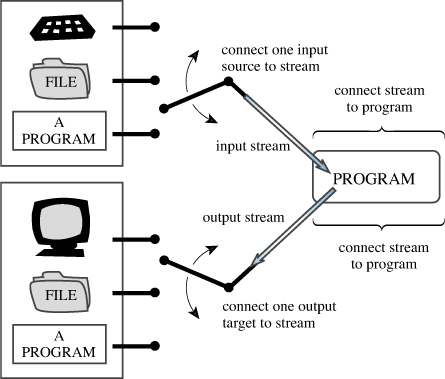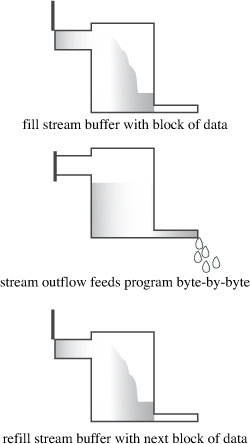Streams and Buffers
A C++ program views input or output as a stream of bytes. On input, a program extracts bytes from an input stream, and on output, a program inserts bytes into the output stream. For a text-oriented program, each byte can represent a character. More generally, the bytes can form a binary representation of character or numeric data. The bytes in an input stream can come from the keyboard, but they can also come from a storage device, such as a hard disk, or from another program. Similarly, the bytes in an output stream can flow to the display, to a printer, to a storage device, or to another program. A stream acts as an intermediary between the program and the stream’s source or destination. This approach enables a C++ program to treat input from a keyboard in the same manner it treats input from a file; the C++ program merely examines the stream of bytes without needing to know where the bytes come from. Similarly, by using streams, a C++ program can process output in a manner independent of where the bytes are going. Managing input, then, involves two stages:
• Associating a stream with an input to a program
• Connecting the stream to a file
In other words, an input stream needs two connections, one at each end. The file-end connection provides a source for the stream, and the program-end connection dumps the stream outflow into the program. (The file-end connection can be a file, but it can also be a device, such as a keyboard.) Similarly, managing output involves connecting an output stream to the program and associating some output destination with the stream. It’s like plumbing with bytes instead of water (see Figure 17.1).
Figure 17.1. C++ input and output.

Usually, input and output can be handled more efficiently by using a buffer. A buffer is a block of memory used as an intermediate, temporary storage facility for the transfer of information from a device to a program or from a program to a device. Typically, devices such as disk drives transfer information in blocks of 512 bytes or more, whereas programs often process information 1 byte at a time. The buffer helps match these two disparate rates of information transfer. For example, assume that a program is supposed to count the number of dollar signs in a hard-disk file. The program could read one character from the file, process it, read the next character from the file, and so on. Reading a file a character at a time from a disk requires a lot of hardware activity and is slow. The buffered approach is to read a large chunk from the disk, store the chunk in the buffer, and read the buffer one character at a time. Because it is much quicker to read individual bytes of data from memory than from a hard disk, this approach is much faster as well as easier on the hardware. Of course, after the program reaches the end of the buffer, the program should then read another chunk of data from the disk. The principle is similar to that of a water reservoir that collects megagallons of runoff water during a big storm and then feeds water to your home at a more civilized rate of flow (see Figure 17.2). Similarly, on output, a program can first fill the buffer and then transfer the entire block of data to a hard disk, clearing the buffer for the next batch of output. This is called flushing the buffer. Perhaps you can come up with your own plumbing-based analogy for that process.
Figure 17.2. A stream with a buffer.

Keyboard input provides one character at a time, so in that case, a program doesn’t need a buffer to help match different data transfer rates. However, buffered keyboard input allows the user to back up and correct input before transmitting it to a program. A C++ program normally flushes the input buffer when you press Enter. That’s why the examples in this book don’t begin processing input until you press Enter. For output to the display, a C++ program normally flushes the output buffer when you transmit a newline character. Depending on the implementation, a program may flush input on other occasions, too, such as at impending input. That is, when a program reaches an input statement, it flushes any output currently in the output buffer. C++ implementations that are consistent with ANSI C should behave in that manner.
